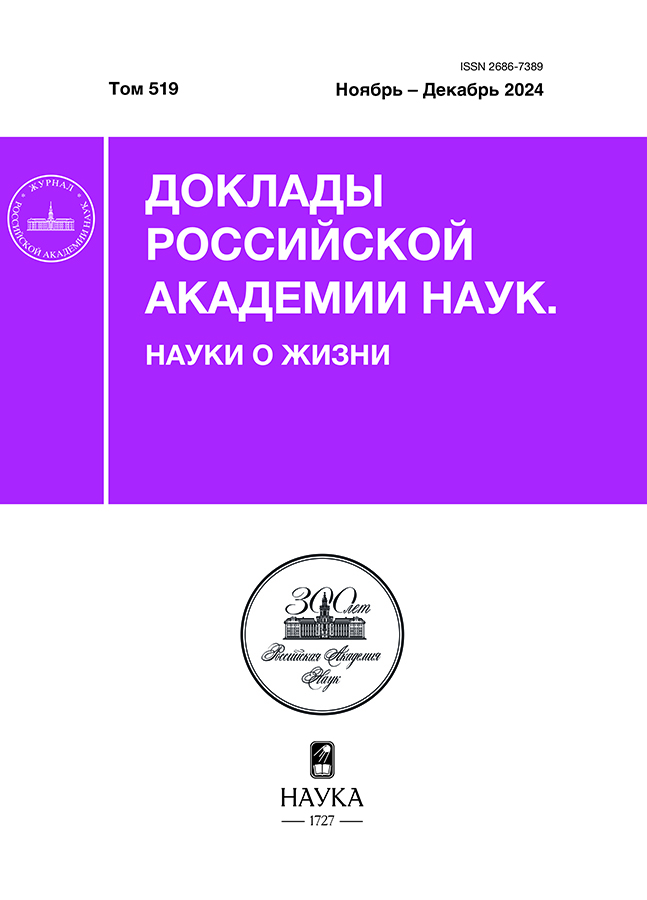The development of antibiotic resistance of the probiotic strain Lactiplantibacillus plantarum 8P-A3 is associated with changes in the structure of extracellular vesicules and the character of their effect on bacterial biofilms
- 作者: Chernova O.A.1, Kayumov A.R.2, Markelova M.I.1,2, Salnikov V.V.1, Kutyreva M.P.2, Khannanov A.A.2, Fedorova M.S.2, Zhuravleva D.E.2, Baranova N.B.1,2, Faizullin D.A.1, Zuev Y.F.1, Chernov V.M.1
-
隶属关系:
- Kazan Institute of Biochemistry and Biophysics of Kazan Science Centre of the Russian Academy of Science
- Kazan Federal University
- 期: 卷 519, 编号 1 (2024)
- 页面: 35-41
- 栏目: Articles
- URL: https://pediatria.orscience.ru/2686-7389/article/view/651378
- DOI: https://doi.org/10.31857/S2686738924060059
- ID: 651378
如何引用文章
详细
For the first time, it was shown that the development of resistance to antibiotics (amoxicillin and clarithromycin) in vitro in the probiotic strain Lactiplantibacillus plantarum 8p-a3, associated with large-scale genomic rearrangements, a change in the profile of phenotypic sensitivity to antimicrobials of different groups, and the evolution of virulence, is also accompanied by significant changes in the lactobacillus-derived extracellular membrane vesicles transferring lipids, polysaccharides, proteins, and nucleic acids. The changes are related to the structure and cargo of vesicles, as well as their activity against biofilms of opportunistic bacteria. The data obtained are relevant for understanding the molecular mechanisms of survival of microorganisms under the selective pressure of antimicrobials, the functional potential of the probiotic vesicles and assessing their safety.
全文:
作者简介
O. Chernova
Kazan Institute of Biochemistry and Biophysics of Kazan Science Centre of the Russian Academy of Science
Email: kairatr@yandex.ru
俄罗斯联邦, Kazan
A. Kayumov
Kazan Federal University
编辑信件的主要联系方式.
Email: kairatr@yandex.ru
俄罗斯联邦, Kazan
M. Markelova
Kazan Institute of Biochemistry and Biophysics of Kazan Science Centre of the Russian Academy of Science; Kazan Federal University
Email: kairatr@yandex.ru
俄罗斯联邦, Kazan; Kazan
V. Salnikov
Kazan Institute of Biochemistry and Biophysics of Kazan Science Centre of the Russian Academy of Science
Email: kairatr@yandex.ru
俄罗斯联邦, Kazan
M. Kutyreva
Kazan Federal University
Email: kairatr@yandex.ru
俄罗斯联邦, Kazan
A. Khannanov
Kazan Federal University
Email: kairatr@yandex.ru
俄罗斯联邦, Kazan
M. Fedorova
Kazan Federal University
Email: kairatr@yandex.ru
俄罗斯联邦, Kazan
D. Zhuravleva
Kazan Federal University
Email: kairatr@yandex.ru
俄罗斯联邦, Kazan
N. Baranova
Kazan Institute of Biochemistry and Biophysics of Kazan Science Centre of the Russian Academy of Science; Kazan Federal University
Email: kairatr@yandex.ru
俄罗斯联邦, Kazan; Kazan
D. Faizullin
Kazan Institute of Biochemistry and Biophysics of Kazan Science Centre of the Russian Academy of Science
Email: kairatr@yandex.ru
俄罗斯联邦, Kazan
Y. Zuev
Kazan Institute of Biochemistry and Biophysics of Kazan Science Centre of the Russian Academy of Science
Email: kairatr@yandex.ru
俄罗斯联邦, Kazan
V. Chernov
Kazan Institute of Biochemistry and Biophysics of Kazan Science Centre of the Russian Academy of Science
Email: kairatr@yandex.ru
俄罗斯联邦, Kazan
参考
- Gill S., Catchpole R., Forterre P. // FEMS Microbiol. Rev. 2019. V. 43,3. P. 273–303.
- Kim W., Lee E. J., Bae I. H., et al. // J. Extracell. Vesicles. 2020. V. 9,1. P. 1793514.
- Charpentier L.A., Dolben E.F., Hendricks M.R., et al. // Membranes. 2023. V. 13,9. P. 752.
- Dominguez Rubio A.P., D’Antoni C.L., Piuri O.E., et al. // Front. microbiol. 2022. V. 13. P. 864720.
- Krzyzek P., Marinacci B., Vitale I., et al. // Pharmaceutics. 2023. V. 15,2. P. 522.
- da Silva Barreira D., Laurent J., Lourenco J., et al. // Sci. Rep. 2023. V. 13,1. P. 1163.
- Mancino W., Lugli G. A., van Sinderen D., et al. // Microorganisms. 2019. V. 7,12. P. 638.
- Tardy L., Giraudeau M., Hill G. E., et al. // Proc. Natl. Acad. Sci. USA. 2019. V. 116,34. P. 16927–16932.
- Card K.J., Thomas M.D., Graves Jr.J.L., et al. // Proc. Natl. Acad. Sci. USA. 2019. V.118,5. P. e2016886118.
- Chernova O.A., Chernov V.M., Mouzykantov A.A., et al. // Int. J. Antimicrob. Agents. 2021. V. 57,2. P. 106253.
- Kostenko V.V., Mouzykantov A.A., Baranova N.B., et al. // Microbiol. Spectr. 2022. V. 10,3. P. e0236021.
- Chernov V.M., Chernova O.A., Mouzykantov A.A., et al. // Sci. World J. 2011. V. 11. P. 1120–1130.
- Burmatova A., Khannanov A., Gerasimov A., et al. // Polymers. 2023. V. 15,15. P. 3248.
- Zucchiatti P., Mitri E., Kenig S., et al. // Anal. Chem. 2016. V. 88,24. P. 12090–12098.
- Chernov V.M., Mouzykantov A.A., Baranova N.B., et al. // J. Proteom. 2014. V. 110. P. 117–128.
- Baidamshina D.R., Trizna E.Y., Holyavka, M.G., et al. // Sci. Rep. 2017. V.7. P. 46068
- Hobby C.R., Herndon J.L., Morrow C.A., et al. // Microbiologyopen. 2019. V. 8,2. P. e00635.
- Bai Y., Luo B., Zhang Y., et al. // Int. J. Biol. Macromol. 2021. V.185. P.1036–1049.
- Slavetinsky С., Hauser J., Cordula Gekeler C., et al. // eLife . 2022. 11:e66376.
- Arias-Rojas A, Arifah A, Angelidou G., et al. // PLoS Pathog. 2024. V.20,8. P. e1012462.
补充文件













